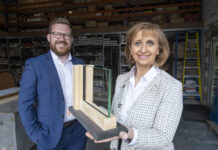
Mike Stevenson, senior manager for strategic markets at NorDan UK, discusses the recent backing of embodied carbon reduction and the challenges of achieving decarbonisation in construction
IF we are truly honest with ourselves, the biggest improvements in the environmental performance of buildings have been driven not from the fear of irreversible climate change, but by the need to comply with new legislation.
Big improvements to operational carbon emissions of buildings have benefited the environment, and of course those who pay for spiralling energy bills.
However, this has only raised the proportional significance and impact of a building’s embodied carbon (those emissions associated with the materials and construction of the building) – so much so that new legislation is on the way.
Last year saw the Future Homes Standard go through several rounds of consultations to improve the Part L (fuel and power) and Part F (ventilation) building regulations, with the aim of reducing operational emissions in residential and non-residential buildings to zero by 2025.
Now embodied carbon is finally being given some attention, with the Carbon Emissions (Buildings) Bill receiving its first reading in February 2022. While there has been a setback to the bill due to an overlap with an MP’s role, hopefully more progress will follow soon.
This bill was intended to legally seek, recognise, and regulate embodied carbon, creating legislation that will factor in the carbon emissions of a building’s whole life under a ‘Part Z’ building regulation in England. Scotland too has been busy with the government publishing its own guidelines under the Net Zero Public Sector Buildings Standard. This standard sees ‘construction – embodied’ [carbon] listed as objective number 2, before operational energy!
Having worked over 30 years in the built environment and having worked across every conceivable window material and design, at NorDan UK, my colleagues and I warmly welcome this bill as an overdue step in the right direction.
In an industry of fierce competition and tight profit margins, it has been hard to reconcile short term financial expediency with longer term sustainable thinking.
The new bill however will move construction to a more honest place, where we face up to the true implications of all the things we do – including how we construct buildings and manufacture the materials and products to do so.
The reality is that embodied carbon can only be radically reduced if we all approach aspects of construction differently.
Unlike a building’s operational carbon emissions, which can be improved and reduced with new technologies, once embodied carbon is emitted into the atmosphere, there’s no going back.
We’re now at the point where embodied carbon accounts for between 20 and 50% of the total emissions generated in a buildings’ lifetime, and construction accounts for almost 40% of total global carbon emissions.
Put another way: once a building is finished the chance to reduce its impact on climate change goes down by between 20 and 50% – and that figure in proportion to operational efficiency is only going to get higher if left unchecked.
Regardless of the proposed legislation, in my opinion it’s time for the industry to ask:
Are building materials truly sustainable and is there a better alternative to help address the climate emergency?
Whole life cost or capital cost – which is more important?
Are we measuring the whole life carbon of the products and methods we use?
I believe that sustainable timber has a vital part to play in answering these questions and reducing embodied carbon in construction.
When grown, harvested, processed and replenished correctly, tree timber is the only truly renewable building material. Carbon negative in growth, CO2 is safely trapped in the material through a process called sequestration for the lifetime of the timber.
NorDan’s aluminium-clad timber window and door frames demonstrate this perfectly. As well as producing 65% less embodied carbon than PVCu and 55% less than solid aluminium (according to BSRIA – the Inventory of Carbon and Energy), they also offer a 60-year life span with minimal maintenance. PVCu (fossil fuel based) window frames, can only meet half of that.
Here lies the challenge: a longer lifespan requires a greater upfront capital investment, so like carbon emissions, the industry must value the whole life cost of a building.
When high quality and sustainable products are given a long enough time to perform, carbon, financial and social sustainability value merge into a single entity.
This is our mission at NorDan and why we are one of the few window manufacturers that has invested heavily in Environmental Product Declarations (EPD), which means we have third party accredited information on our products from material extraction through to end-of-life.
These EPD’s are freely available to clients, architects, specifiers, contractors, and developers to support their respective decision making and puts NorDan at the forefront of evidenced based carbon data in the construction industry, certainly where fenestration is concerned.
Embodied carbon exemplifies of how making changes today can have an instant and irreversible positive impact on climate change.
But we have to choose to see problems for what they are, and if we keep specifying the same high-carbon building products based on habit and price, then we will keep getting the same results.











